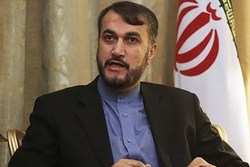 Senior Advisor to the Iranian Parliament Speaker Hossein Amir Abdollahian blasted the US for assassinating commander of the Islamic Revolution Guards Corps Qods Force Commander Lieutenant General Qassem Soleimani, and said that the country’s diplomatic apparatus provided a suitable situation for IRGC’s missile attack on the American troops’ military bases in Iraq.
Senior Advisor to the Iranian Parliament Speaker Hossein Amir Abdollahian blasted the US for assassinating commander of the Islamic Revolution Guards Corps Qods Force Commander Lieutenant General Qassem Soleimani, and said that the country’s diplomatic apparatus provided a suitable situation for IRGC’s missile attack on the American troops’ military bases in Iraq. RNA - “(Iranian) foreign ministry’s strong responses provided good platform for missile attacks by the IRGC against the US military bases in Iraq,” Amir Abdollahian said on Sunday.
He said that the strong diplomatic response of the Foreign Ministry to the Americans, after the assassination of Lieutenant General Soleimani, created a good platform in political and international, and even legal arena for launching missile attacks.
Lieutenant General Soleimani was assassinated by the US along with the acting Commander of the Iraqi Popular Mobilization Units (PMU), known as Hashd al-Shaabi, Abu Mahdi Al-Mohandes, and eight other military forces with record of fighting the ISIL in Iraq.
On January 8, the IRGC Aerospace Force started heavy ballistic missile attacks on US Ein Al-Assad airbase in Southwestern Iraq near the border with Syria and a US operated airbase in Erbil in retaliation for the US assassination of IRGC Qods Force Commander Lieutenant General Qassem Soleimani.
Ein Al-Assad is an airbase with a 4km runway at 188m altitude from sea levels, which is the main and the largest US airbase in Iraq. Early reports said the radar systems and missile defense shields in Ein Al-Assad failed to operate and intercept the Iranian missiles. Unofficial reports said the US army's central radar systems at Ein Al-Assad had been jammed by electronic warfare.
The second IRGC reprisal attack targeted a US military base near Erbil airport in Iraqi Kurdistan Region in the second leg of "Martyr Soleimani" reprisal operation.
Iraq said the attacks had not taken any toll from its army men stationed at these two bases. The US army had blocked entrance into Ein Al-Assad to everyone, including the Iraqi army.
It was the first direct attack on the US army ever since world war two.
The IRGC officials said none of the missiles had been intercepted.
847/940